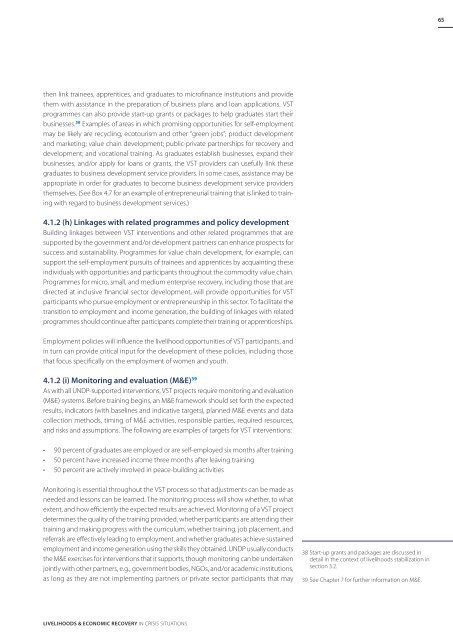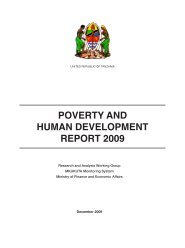Download PDF (4.08 MB) - ReliefWeb
Download PDF (4.08 MB) - ReliefWeb
Download PDF (4.08 MB) - ReliefWeb
You also want an ePaper? Increase the reach of your titles
YUMPU automatically turns print PDFs into web optimized ePapers that Google loves.
65<br />
then link trainees, apprentices, and graduates to microfinance institutions and provide<br />
them with assistance in the preparation of business plans and loan applications. VST<br />
programmes can also provide start-up grants or packages to help graduates start their<br />
businesses. 38 Examples of areas in which promising opportunities for self-employment<br />
may be likely are recycling, ecotourism and other “green jobs”; product development<br />
and marketing; value chain development; public-private partnerships for recovery and<br />
development; and vocational training. As graduates establish businesses, expand their<br />
businesses, and/or apply for loans or grants, the VST providers can usefully link these<br />
graduates to business development service providers. In some cases, assistance may be<br />
appropriate in order for graduates to become business development service providers<br />
themselves. (See Box 4.7 for an example of entrepreneurial training that is linked to training<br />
with regard to business development services.)<br />
4.1.2 (h) Linkages with related programmes and policy development<br />
Building linkages between VST interventions and other related programmes that are<br />
supported by the government and/or development partners can enhance prospects for<br />
success and sustainability. Programmes for value chain development, for example, can<br />
support the self-employment pursuits of trainees and apprentices by acquainting these<br />
individuals with opportunities and participants throughout the commodity value chain.<br />
Programmes for micro, small, and medium enterprise recovery, including those that are<br />
directed at inclusive financial sector development, will provide opportunities for VST<br />
participants who pursue employment or entrepreneurship in this sector. To facilitate the<br />
transition to employment and income generation, the building of linkages with related<br />
programmes should continue after participants complete their training or apprenticeships.<br />
Employment policies will influence the livelihood opportunities of VST participants, and<br />
in turn can provide critical input for the development of these policies, including those<br />
that focus specifically on the employment of women and youth.<br />
4.1.2 (i) Monitoring and evaluation (M&E) 39<br />
As with all UNDP-supported interventions, VST projects require monitoring and evaluation<br />
(M&E) systems. Before training begins, an M&E framework should set forth the expected<br />
results, indicators (with baselines and indicative targets), planned M&E events and data<br />
collection methods, timing of M&E activities, responsible parties, required resources,<br />
and risks and assumptions. The following are examples of targets for VST interventions:<br />
• 90 percent of graduates are employed or are self-employed six months after training<br />
• 50 percent have increased income three months after leaving training<br />
• 50 percent are actively involved in peace-building activities<br />
Monitoring is essential throughout the VST process so that adjustments can be made as<br />
needed and lessons can be learned. The monitoring process will show whether, to what<br />
extent, and how efficiently the expected results are achieved. Monitoring of a VST project<br />
determines the quality of the training provided, whether participants are attending their<br />
training and making progress with the curriculum, whether training, job placement, and<br />
referrals are effectively leading to employment, and whether graduates achieve sustained<br />
employment and income generation using the skills they obtained. UNDP usually conducts<br />
the M&E exercises for interventions that it supports, though monitoring can be undertaken<br />
jointly with other partners, e.g., government bodies, NGOs, and/or academic institutions,<br />
as long as they are not implementing partners or private sector participants that may<br />
38 Start-up grants and packages are discussed in<br />
detail in the context of livelihoods stabilization in<br />
section 3.2.<br />
39 See Chapter 7 for further information on M&E.<br />
Livelihoods & Economic Recovery in Crisis Situations





